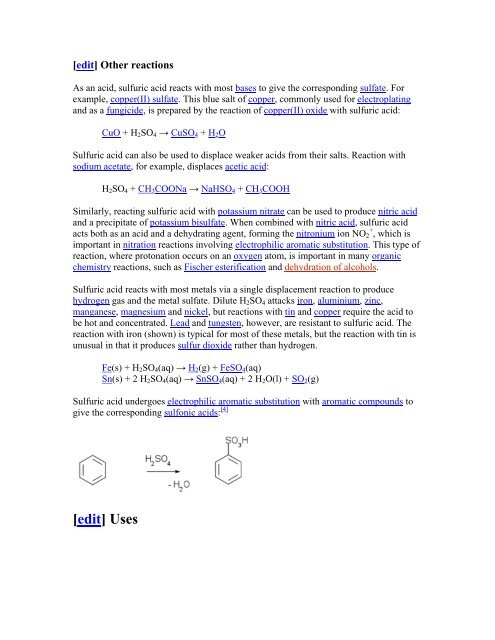Sulfuric acid
Sulfuric acid
Sulfuric acid
- No tags were found...
Create successful ePaper yourself
Turn your PDF publications into a flip-book with our unique Google optimized e-Paper software.
[edit] Other reactionsAs an <strong>acid</strong>, sulfuric <strong>acid</strong> reacts with most bases to give the corresponding sulfate. Forexample, copper(II) sulfate. This blue salt of copper, commonly used for electroplatingand as a fungicide, is prepared by the reaction of copper(II) oxide with sulfuric <strong>acid</strong>:CuO + H 2 SO 4 → CuSO 4 + H 2 O<strong>Sulfuric</strong> <strong>acid</strong> can also be used to displace weaker <strong>acid</strong>s from their salts. Reaction withsodium acetate, for example, displaces acetic <strong>acid</strong>:H 2 SO 4 + CH 3 COONa → NaHSO 4 + CH 3 COOHSimilarly, reacting sulfuric <strong>acid</strong> with potassium nitrate can be used to produce nitric <strong>acid</strong>and a precipitate of potassium bisulfate. When combined with nitric <strong>acid</strong>, sulfuric <strong>acid</strong>acts both as an <strong>acid</strong> and a dehydrating agent, forming the nitronium ion NO 2 + , which isimportant in nitration reactions involving electrophilic aromatic substitution. This type ofreaction, where protonation occurs on an oxygen atom, is important in many organicchemistry reactions, such as Fischer esterification and dehydration of alcohols.<strong>Sulfuric</strong> <strong>acid</strong> reacts with most metals via a single displacement reaction to producehydrogen gas and the metal sulfate. Dilute H 2 SO 4 attacks iron, aluminium, zinc,manganese, magnesium and nickel, but reactions with tin and copper require the <strong>acid</strong> tobe hot and concentrated. Lead and tungsten, however, are resistant to sulfuric <strong>acid</strong>. Thereaction with iron (shown) is typical for most of these metals, but the reaction with tin isunusual in that it produces sulfur dioxide rather than hydrogen.Fe(s) + H 2 SO 4 (aq) → H 2 (g) + FeSO 4 (aq)Sn(s) + 2 H 2 SO 4 (aq) → SnSO 4 (aq) + 2 H 2 O(l) + SO 2 (g)<strong>Sulfuric</strong> <strong>acid</strong> undergoes electrophilic aromatic substitution with aromatic compounds togive the corresponding sulfonic <strong>acid</strong>s: [4][edit] Uses
















